5 Foundations Of Lean Leadership For Pharmaceutical & Medical Device Professionals
By Jayet Moon, author of the book Foundations of Quality Risk Management
The methods and tools related to lean manufacturing or the Toyota Production System[1] have gained much currency over the past decades after the global success of Japanese companies since the 1970s. By now, many professionals are familiar with words such as Kaizen, Kanban, 5S, Poke Yoke, and Just-in-Time (JIT). However, the fanfare around these tools often leads people to ignore the cultural and leadership aspects of lean, which at its foundation are responsible for the success or failure of a lean transformation. A true lean system comprises a production and management system that is focused on eliminating inefficiencies and waste and maximizing value-added activities to generate maximum value for all stakeholders, which may mean less cost, more profit, safer products, and greater societal benefits.
The medical device and pharmaceutical sectors are regulated by the government; hence, there are barriers to entry. This leads to a semi-protected market where margins are much higher than in a traditionally open market for, say, automobiles, where lean first originated and gained popularity. With these higher margins comes a certain tolerance for inefficiencies, which in lean parlance is called waste. However, every company, now more than ever before, is on a journey to provide greater returns to stakeholders by manufacturing products at better quality and lower cost – this is exactly the aim of lean. In regulated industries, the protected market can often provide a false sense of security, thus a consistent and continuous stimulus and impetus for a lean transformation has to come from the top management and leadership.
But What Do The Foundations Of Lean Culture & Leadership Look Like?
Five principles detailed below provide a glimpse into the precepts and key factors of lean that enable the successful use of methods and tools.
1. Recognize Value – Monozukuri (物造り), Hitozukuri (人作り), & Kotozukuri (事作り)
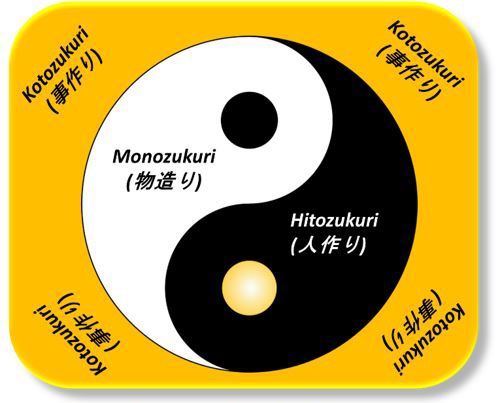
Hitozukuri (人作り) literally means “making-people.” This is the second aspect of value addition, to which leaders often do not give enough attention. While the manufacturing floor creates product every day, and the product can be seen and touched as a tangible value output, producing value in people is sometimes hard to measure. For leaders, it is about developing value in people so that they can add more value to the product. Leaders can thus create a virtuous cycle of improvement.
Kotozukuri (事作り)[3] is the actionable manifestation of the previous two zukuris that should be front and center in the lean professional’s mind. It literally means “making business happen.” This is the leadership goal. It focuses on holistic value creation encompassing, encouraging, and harmonizing both mono- and hitozukuri. Kotozukuri can take various forms in different organizations depending on their strategic goals. It’s about generating passion in employees to leverage personal and professional strengths to overcome challenges and capitalize on opportunities to achieve benchmark organizational excellence. The beauty of the Japanese concept is that it applies and has to be practiced at every level – not just the boardroom.
2. Getting Your Boots On The Ground – Genchi Genbutsu (現地現物)
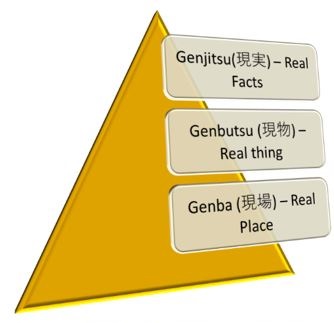
Leaders who get their genchi genbutsu on have first-hand real information and data that informs their decisions, as opposed to leaders who rely on second- or third-hand reports. Such leaders understand that any decision is only as good as the information that feeds it and they make an attempt to get the state of reality, however good or bad it is.
The shift to virtual and remote work due to the COVID-19 pandemic has made genba walks difficult, but that does not mean one should compromise on genbutsu and genjitsu. If anything, it is more important now to base decisions on objective facts. If it is not possible to observe through your own eyes, make sure you directly interface with someone who has his or her eyes on the genba and ask questions from every angle to digest the value addition (or removal) process so that targeted and correct improvement actions can be taken.
3. Continuous Improvement & Breakthrough Improvement – Kaizen (改善) and Kaikaku (改革)
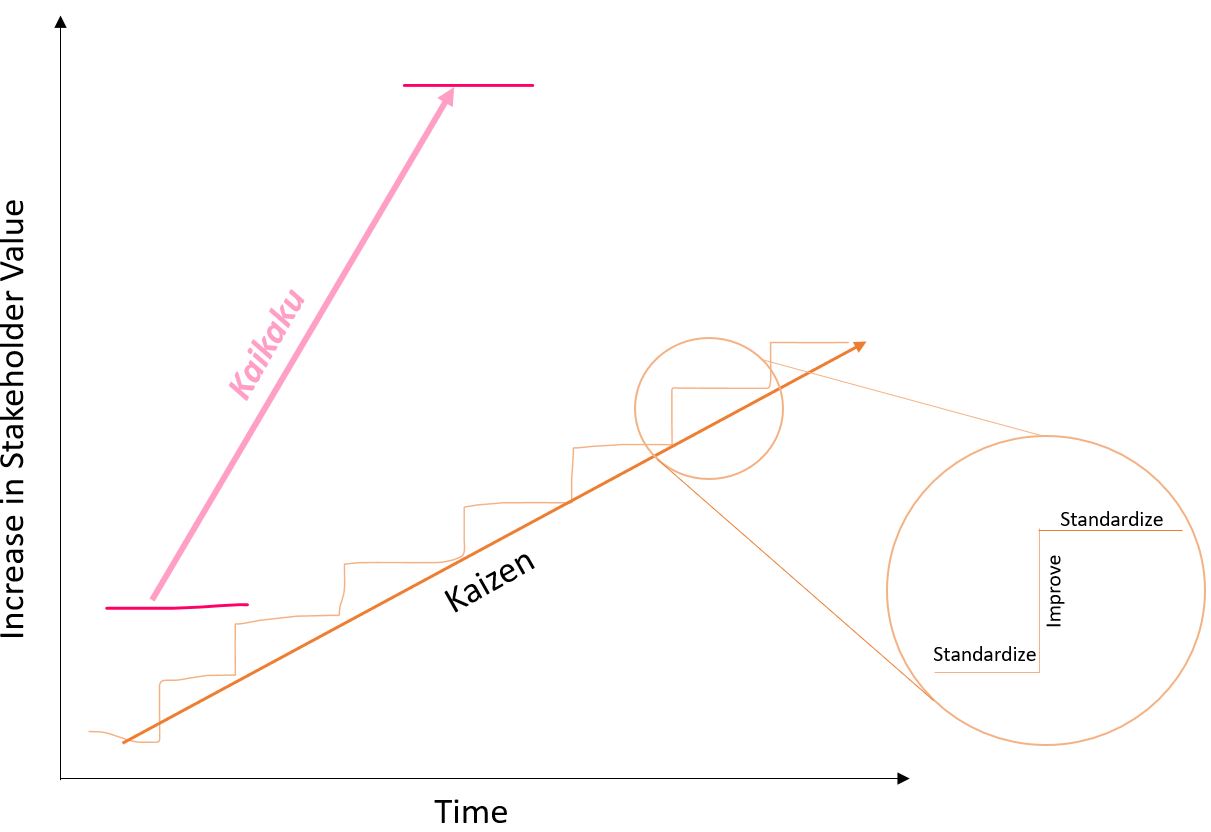
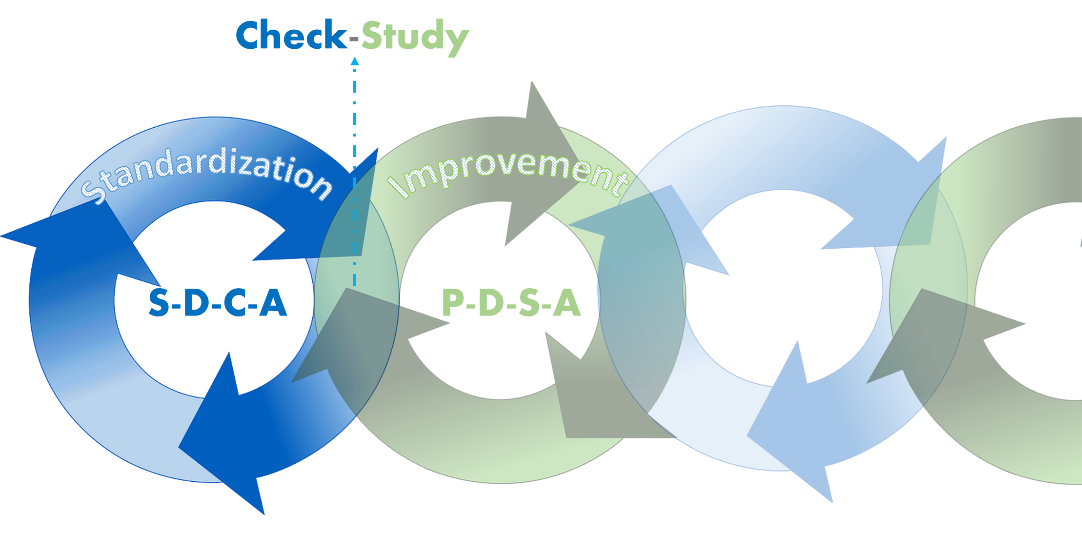
Kaikaku is breakthrough improvement, literally translated as “reform.” Leaders should recognize that there are times when small improvements do not suffice, and a brand-new method or approach is needed to ensure customer satisfaction. This is called kaikaku, or radical change. When developing new products, such as medical devices, kaizen may mean expanding an indication of a product by small design or specification changes, while kaikaku may mean developing a radically new product that may have the same intended use but with a completely different design and operational parameters. In spinal devices, designing a new cervical cage or spacer with coating for improved bone attachment and retention is an example of an incremental improvement, while a totally new approach, such as an artificial cervical disc (first approved by the FDA in 2004), is a breakthrough improvement over the cage and spacers. The FDA now, in fact, has a separate pathway for approval of breakthrough therapies and medical devices.[5],[6] Another similar-sounding Japanese word is kaiaku (改悪), which means deterioration or changing for the worse. Kaizen and kaikaku not done right may lead to kaiaku!
4. Self-Reflection – Hansei (反省)
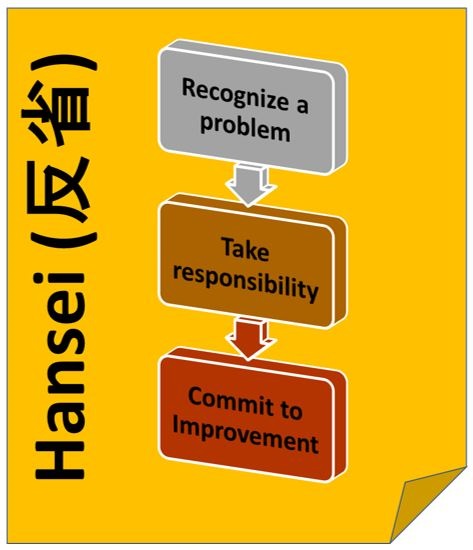
In the West, where failures are seen as negative, discussion around them is avoided, while successes are overemphasized. In the Japanese hansei process, the focus is on the mistakes and what went wrong, since failures provide a rich source of lessons for improvement opportunities.
The hansei process is based on first recognizing problems as they are, without any sugarcoating, then one should take full responsibility (this makes it personal), and, finally and most importantly, the person commits to improvement through a specific course of action. Learning lessons is very important in a lean culture, and the famous saying “no problem is a problem” is often quoted. Even when a project is successful, hansei-kai[7] meetings are held to discuss what could have been done better or which parts of the process did not go as expected, for improvements next time around.
5. Honor And Respect For People – Ningensoncho (人間尊重) and Ningenseisoncho (人間性尊重)
Ningensoncho (人間尊重) means honor and respect for people. The employees of a company should feel respected and be comfortable in their roles so they can contribute without hesitation to the problem-solving process. Respecting people means respecting their work, ideas, views, and thoughts. Leaders should recognize that this can unleash creative potential that no machine can match, thus the focus should be on continually developing people.
Ningenseisoncho (人間性尊重) means respect for humanity. This takes a wider view than the previous term and is a founding precept of the Toyota Motor Company.[8] The following guiding principles make this amply clear:[9]
- Honor the language and spirit of the law of every country and region, and undertake open and fair business activities to be a strong corporate citizen of the world.
- Respect the culture and customs of every country and region, and contribute to economic and social development through corporate activities in their respective communities.
- Dedicate our business to providing clean and safe products and to enhancing the quality of life everywhere through all of our activities.
- Create and develop advanced technologies and provide outstanding products and services that fulfill the needs of customers worldwide.
- Foster a corporate culture that enhances both individual creativity and the value of teamwork, while honoring mutual trust and respect between labor and management.
- Pursue growth through harmony with the global community via innovative management.
- Work with business partners in research and manufacturing to achieve stable, long-term growth and mutual benefits, while remaining open to new partnerships.
Lean, as understood through the Toyota Way, is built on two pillars: continuous improvement, which takes in the concepts of kaizen and genchi genbutsu, and respect for people.[10],[11]The global challenges created by the pandemic have made it clear that these pillars are more important than ever. A lean enterprise does not mean just a set of tools to improve production volume or lower cost or cycle times. Once the cultural foundations of lean are in place, improvements can easily tackle waste such as defects, overproduction, waiting, unused talent, and transportation, as well as excess inventory, overprocessing, and excess motion. Lean is a philosophy and a culture that enables great improvements by engaging and empowering employees by harnessing their creative problem-solving minds. These principles are in natural harmony with the mission of medical device and pharmaceutical companies and can provide solid foundations to achieve sustained organizational excellence, stakeholder satisfaction, and societal benefits.
About The Author:
 Jayet Moon earned a master’s degree in biomedical engineering from Drexel University in Philadelphia and is a Project Management Institute (PMI)-Certified Risk Management Professional (PMI-RMP). Jayet is also a Chartered Quality Professional in the UK (CQP-MCQI). He is also an Enterprise Risk Management Certified Professional (ERMCP) and a Risk Management Society (RIMS)-Certified Risk Management Professional (RIMS-CRMP). He is a Fellow of the International Institute of Risk & Safety Management. His new book, Foundations of Quality Risk Management, was recently released by ASQ Quality Press. He holds ASQ CQE, CQSP, and CQIA certifications.
Jayet Moon earned a master’s degree in biomedical engineering from Drexel University in Philadelphia and is a Project Management Institute (PMI)-Certified Risk Management Professional (PMI-RMP). Jayet is also a Chartered Quality Professional in the UK (CQP-MCQI). He is also an Enterprise Risk Management Certified Professional (ERMCP) and a Risk Management Society (RIMS)-Certified Risk Management Professional (RIMS-CRMP). He is a Fellow of the International Institute of Risk & Safety Management. His new book, Foundations of Quality Risk Management, was recently released by ASQ Quality Press. He holds ASQ CQE, CQSP, and CQIA certifications.
[1] Womack, James P., Daniel T. Jones, and Daniel Roos. The machine that changed the world: The story of lean production--Toyota's secret weapon in the global car wars that is now revolutionizing world industry. Simon and Schuster, 2007.
[2] Watson Gregory, Exercising Management Roles of Front-Line Leadership, Lecture to ASQ Lean Enterprise Division 27 May 2021.
[3] https://planet-lean.com/monozukuri-hitozukuri-kotozukuri/
[4] Watson, Gregory H., Planning for Business Success: Hoshin Kanri at Toyota, Lecture at ESTIEM, Porto, Portugal 30 October 2017
[5] https://www.fda.gov/medical-devices/how-study-and-market-your-device/breakthrough-devices-program
[6] https://www.fda.gov/patients/fast-track-breakthrough-therapy-accelerated-approval-priority-review/breakthrough-therapy
[7] https://www.leansixsigmadefinition.com/glossary/hansei/
[8] https://michelbaudin.com/2014/04/12/more-on-toyotas-respect-for-humanity/#humanity_versus_people
[9] https://global.toyota/en/company/vision-and-philosophy/guiding-principles/
[10] https://www.toyota-europe.com/world-of-toyota/this-is-toyota/the-toyota-way
[11] https://www.lean.org/womack/DisplayObject.cfm?o=755

